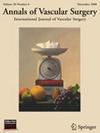血管内超声(IVUS)测量动脉粥样硬化切除术后管腔增益及其对中期结果的影响。
IF 1.6
4区 医学
Q3 PERIPHERAL VASCULAR DISEASE
引用次数: 0
摘要
目的:虽然动脉粥样硬化切除术通常用于周围血管干预,但缺乏有关动脉粥样硬化切除术本身的管腔增益程度的多平面数据。我们评估了通过血管内超声(IVUS)在不同的动脉粥样硬化切除术装置中测量的即时管腔增益百分比。我们还评估了双工超声(DUS)测量的短期通畅度和中期临床随访。方法:我们前瞻性地收集了145例特殊患者156例连续下肢血运重建术的数据(11例双侧分期干预)。动脉粥样硬化切除术后总是进行球囊血管成形术,选择性使用支架植入术。干预的适应症是症状(Rutherfor Class 3-6),并伴有IVUS检查的病变70%面积狭窄,IVUS还可识别病变长度、钙化情况以及动脉粥样硬化切除术前后的狭窄百分比。这一差异代表单独动脉粥样硬化切除术后管腔增加的百分比。随访30天后进行DUS,以确定残余/复发狭窄的比例为70%。对患者进行临床随访,以确定改善的发生率、临床驱动的靶区血管重建术(cdTLRs)、是否需要开腹手术和截肢。结果:治疗卢瑟福3-5级缺血。156条肢体共治疗260个病变,其中支架内再狭窄51例,全闭塞55例。209例(80.1%)病变位于股腘分布。中位管腔增益为26.4% (IQR 23;31) %,胫骨血管明显高于股腘血管(p=0.009)。46例(22.2%)股骨-腘窝病变需要支架植入术,胫骨段不需要。30天DUS评估的狭窄率为70%,2.3%的治疗病变存在狭窄。平均随访15.2±3.3个月。53例(34%)行CdTLR,其中3例(1.9%)行开放血运重建术,2例(1.3%)行大截肢,均为Rutherford分类4-5。由于在所有过程中光热增益的范围很窄,我们没有看到光热增益的程度对cdTLR的发生或时间的影响(HR 1.006(95% CI 0.978-1.036), p=0.660)。CdTLR与最初是否存在闭塞、病变长度和支架再狭窄作为干预的初始指征有关。结论:动脉粥样硬化切除术的中位管腔增益始终为26.4%,这在不同的动脉粥样硬化切除术装置之间是相似的,并且取决于基线血管大小。在这个系列中,支架置入是罕见的,没有支架放置在胫骨位置。CdTLR不受钙化程度或动脉粥样硬化切除术导致的管腔增益百分比的影响。在所有卢瑟福分类中,大多数患者均有改善,开放干预和截肢率较低,仅限于慢性肢体威胁缺血患者。本文章由计算机程序翻译,如有差异,请以英文原文为准。
Luminal Gain after Atherectomy Measured by Intravascular Ultrasound (IVUS) and Impact on Mid-Term Results
Background
While atherectomy is commonly used in peripheral vascular interventions, multiplanar data regarding the degree of luminal gain from the atherectomy procedure itself is lacking. We assessed immediate percent luminal gain, measured by intravascular ultrasound (IVUS) in different atherectomy devices. We also evaluated short-term patency measured by duplex ultrasound (DUS) and mid-term clinical follow-up.
Methods
We prospectively collected data on 156 consecutive lower extremity revascularizations for 145 unique patients (11 bilateral staged interventions). Atherectomy was always followed by balloon angioplasty, with selective use of stenting. Indications for intervention were symptoms (Rutherford class 3–6) combined with lesions 70% area stenosis assessed by IVUS. IVUS also identified lesion length, calcification, and percent stenosis pre- and immediately post-atherectomy. This difference represented percent luminal gain by atherectomy alone. Follow-up DUS was performed at 30 days to identify residual/recurrent stenosis > 70%. Patients were followed up clinically to determine incidence of improvement, clinically driven target lesion revascularizations (cdTLRs), need for open surgery, and amputations.
Results
Patients were treated for Rutherford class 3–5 ischemia. Two hundred sixty (260) lesions were treated in 156 limbs, including 51 in-stent restenosis (ISR) and 55 total occlusions. Two hundred nine (80.1%) lesions were in femoral-popliteal distribution. Median luminal gain was 26.4 (interquartile range 23; 31) % and was significantly higher in tibial than femoral-popliteal vessels (P = 0.009). Stenting was required in 46 (22.2%) of femoral-popliteal lesions and no tibial segments. Stenosis > 70% assessed by DUS at 30 days was present in 2.3% of treated lesions. Mean follow-up was 15.2 ± 3.3 months. CdTLR was performed in 53 cases (34%), including 3 (1.9%) open revascularization and major amputation in 2 (1.3%) legs, both Rutherford Class 4–5. Due to the tight range of luminal gain across all procedures, we saw no effect of the degree of luminal gain on the occurrence or timing of cdTLR (hazard ratio 1.006 (95% confidence interval 0.978–1.036), P = 0.660). CdTLR was related to initial presence of occlusion, lesion length, and ISR as the initial indication for intervention.
Conclusion
Atherectomy consistently results in median luminal gain of 26.4%, which is similar between different atherectomy devices and depends on the baseline vessel size. In this series stent placement was infrequent, with no stents placed in the tibial position. CdTLR was not influenced by degree of calcification or percent luminal gain attributed to atherectomy. There was improvement in the majority of patients across all Rutherford categories, with a low rate of open intervention and amputation, which was restricted to patients with chronic limb-threatening ischemia.
求助全文
通过发布文献求助,成功后即可免费获取论文全文。
去求助
来源期刊
CiteScore
3.00
自引率
13.30%
发文量
603
审稿时长
50 days
期刊介绍:
Annals of Vascular Surgery, published eight times a year, invites original manuscripts reporting clinical and experimental work in vascular surgery for peer review. Articles may be submitted for the following sections of the journal:
Clinical Research (reports of clinical series, new drug or medical device trials)
Basic Science Research (new investigations, experimental work)
Case Reports (reports on a limited series of patients)
General Reviews (scholarly review of the existing literature on a relevant topic)
Developments in Endovascular and Endoscopic Surgery
Selected Techniques (technical maneuvers)
Historical Notes (interesting vignettes from the early days of vascular surgery)
Editorials/Correspondence

 求助内容:
求助内容: 应助结果提醒方式:
应助结果提醒方式:


